人教版(2019)必修第一册Unit 5 Languages Around the World Discovering Useful Structures 课件(共27张PPT)
文档属性
| 名称 | 人教版(2019)必修第一册Unit 5 Languages Around the World Discovering Useful Structures 课件(共27张PPT) |  | |
| 格式 | pptx | ||
| 文件大小 | 1.6MB | ||
| 资源类型 | 教案 | ||
| 版本资源 | 人教版(2019) | ||
| 科目 | 英语 | ||
| 更新时间 | 2024-04-10 19:56:36 | ||
图片预览

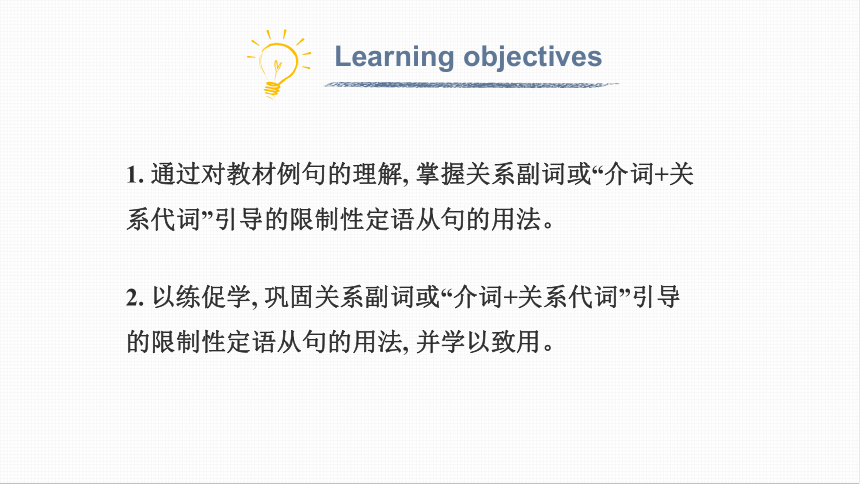
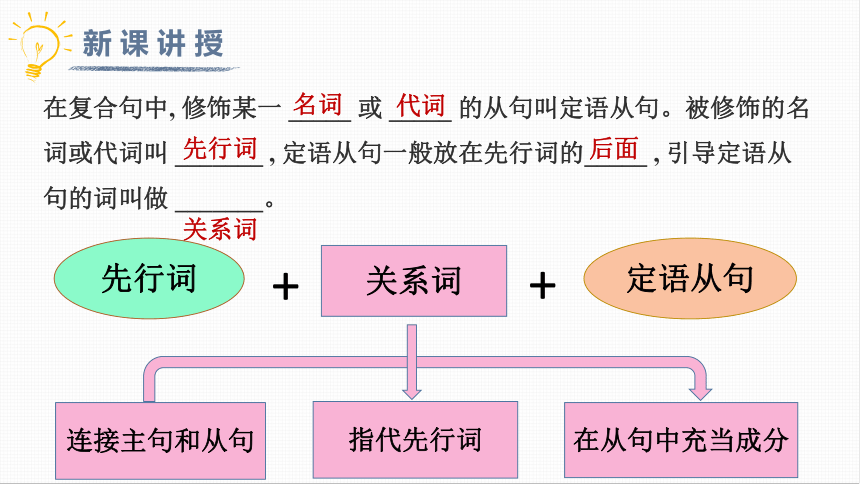
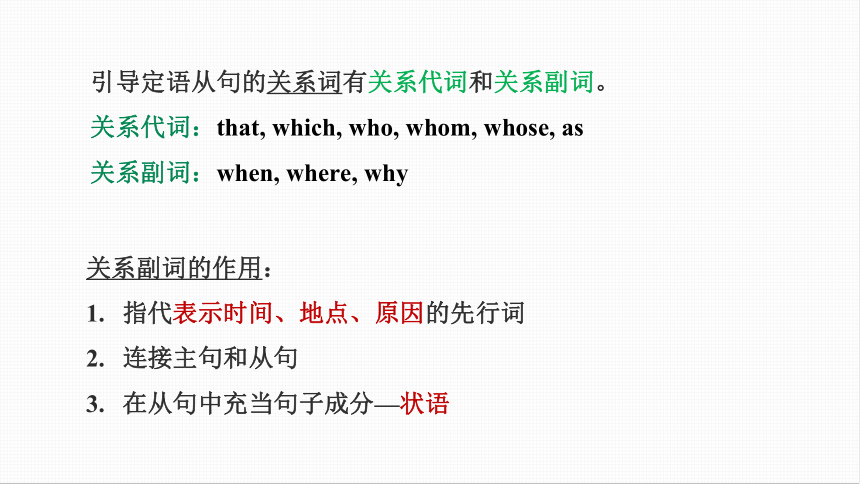
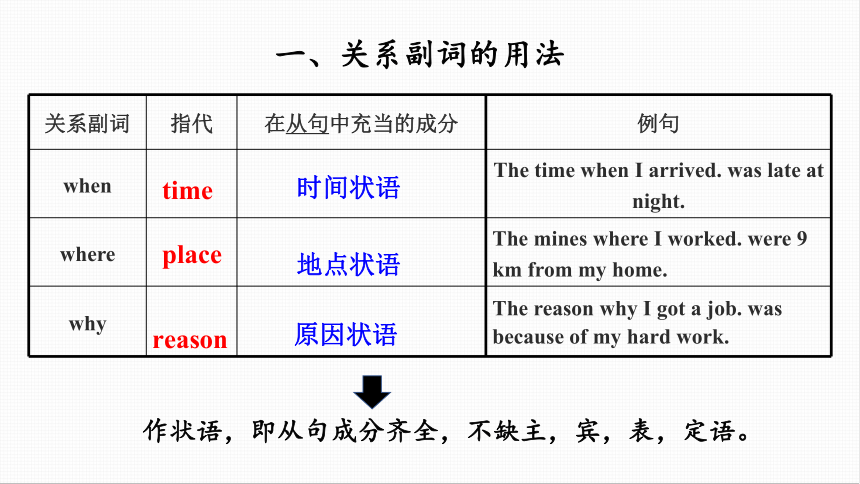
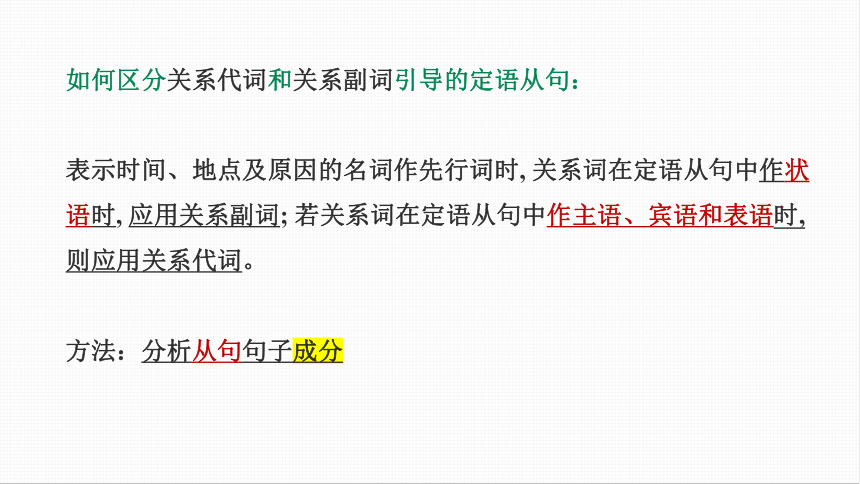
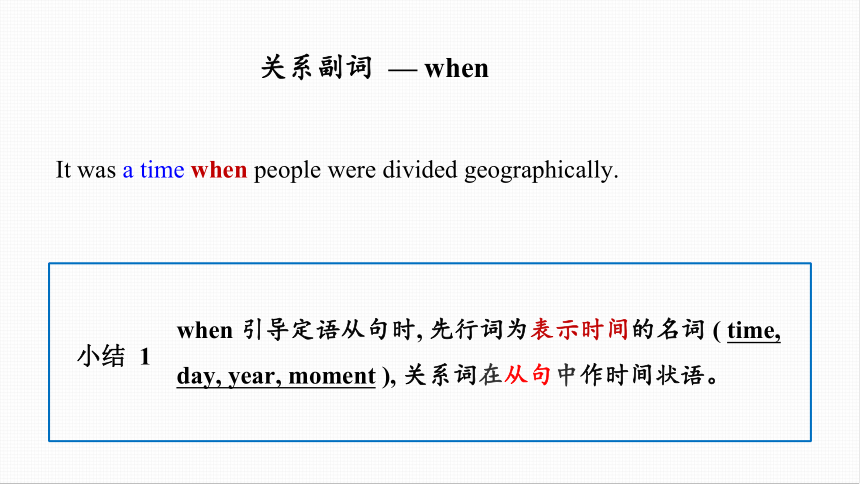


文档简介
(共27张PPT)
Unit 5
Discovering Useful Structures
定语从句——关系副词
(where, when, why, prep.+which/whom)
1. 通过对教材例句的理解, 掌握关系副词或“介词+关系代词”引导的限制性定语从句的用法。
2. 以练促学, 巩固关系副词或“介词+关系代词”引导的限制性定语从句的用法, 并学以致用。
Learning objectives
在复合句中, 修饰某一 _____ 或 _____ 的从句叫定语从句。被修饰的名词或代词叫 _______ , 定语从句一般放在先行词的_____ , 引导定语从句的词叫做 _______。
先行词
后面
关系词
名词
代词
先行词
关系词
定语从句
+
+
指代先行词
连接主句和从句
在从句中充当成分
新 课 讲 授
关系副词的作用:
指代表示时间、地点、原因的先行词
连接主句和从句
在从句中充当句子成分—状语
引导定语从句的关系词有关系代词和关系副词。
关系代词:that, which, who, whom, whose, as
关系副词:when, where, why
关系副词 指代 在从句中充当的成分 例句
when The time when I arrived. was late at night.
where The mines where I worked. were 9 km from my home.
why The reason why I got a job. was because of my hard work.
一、关系副词的用法
time
时间状语
place
reason
地点状语
原因状语
作状语,即从句成分齐全,不缺主,宾,表,定语。
如何区分关系代词和关系副词引导的定语从句:
表示时间、地点及原因的名词作先行词时, 关系词在定语从句中作状语时, 应用关系副词; 若关系词在定语从句中作主语、宾语和表语时, 则应用关系代词。
方法:分析从句句子成分
It was a time when people were divided geographically.
小结 1
when 引导定语从句时, 先行词为表示时间的名词 ( time, day, year, moment ), 关系词在从句中作时间状语。
关系副词 — when
Emperor Qinshihuang united the seven major states into one unified country where the Chinese writing system began to develop in one direction.
小结 2
where引导定语从句时, 先行词为表示地点的名词 (place, spot, house, room, city, town, country), 关系词在从句中作地点状语。
关系副词 — where
where 还可用在表示抽象意义的地点名词后, 如 situation (情形), stage (阶段), point (地步), case (情况), position (位置), condition, activity, scene, occasion等,意思是“到了某种地步, 在某种境况或情况中” 。
The accident has reached to the point where both their parents are to be called in.
关系副词 — where
特别提示
并非所有的表示“时间”和“地点”的先行词,后面的定语从句一定要用when和where引导。如果定语从句中缺少主语或宾语,就要用that或which引导。
This is the house _____________ my father built last year.
Do you still remember the days ___________ we spent in the countryside
that/which
that/which
判断先行词在从句中的成分,用正确的关系词填空。
This is the reason _______________ he went.
The reason _______________ he gave us was quite reasonable.
This is the place ____________ we visited last year.
This is the place ____________ he works.
That was the time ____________ he arrived.
Do you still remember the time ____________ we spent together
which/that
where
when
that/which
why/for which
that/which
Practice
There are many reasons why people learn a foreign language.
小结 3
why 引导定语从句时,先行词通常是reason , 关系词在从句中作原因状语。
关系副词 — why
二、“介词+关系代词”引导的定语从句
关系副词when, where, why引导定语从句时, 关系副词也可用“介词+关系代词”代替。
1. 关系代词的确定
在“介词+关系代词”引导的定语从句中, 关系代词只能用which或whom, 先行词指物时, 用which; 先行词指人时, 用whom。
He is the man in whom you can believe.
(1)看介词与定语从句中动词或形容词的搭配。
He gave me some books with which I am not very familiar.
(2)看介词与先行词搭配。
This is our classroom in which there is a teacher’s desk.
The farm on which my father works is far from the town.
(3)根据句子的意思而定。
The soldier, without whom I wouldn't have survived the earthquake, retired last week.
2. 介词的确定
The patient whom she is looking after is her father.
并非所有介词都可以放到关系代词前
有些“动词+介词”被视为一个固定的词组, 不可分割, 这时不能把介词置于关系代词前, 如:look for, look after, pay attention to, take care of , look forward to, go through等。
The patient after whom she is looking is her father.
×
特别提示:
1. The film star _____________ we talked a lot yesterday will give us a speech tomorrow.
2. The West Lake _________ Hangzhou is famous in the world will be more beautiful.
3. This is my glasses, ________________ I can’t see clearly.
about whom
for which
without which
用“介词+关系代词”填空
Practice
4. The reason _________ he could not go there was that his grades was too low.
5. Who is the person __________ you just shook hands
6. Could you tell me the day ________ you arrived
7. I will treasure the days ________ I lived here.
with whom
on which
in which
for which
定语从句三步解体法:
一、先找出主句;
二、确定先行词
三、判断关系词在从句中做的成分
定
语
从
句
的
引
导
词
关系代词
关系副词
指人
指物
that(主语/宾语/表语), which(主语/宾语),who(主语/宾语), whom(宾语), whose(定语),as(主语/宾语/表语)
that(主语、宾语), which(主语、宾语), whose(定语)
where (地点状语)
when (时间状语)
why (原因状语)
Ps:关系词在从句中做状语时,连接词有时可以用介词+which/whom来替换关系副词
Discovering- Look at these sentences and underline the restrictive attributive clauses. What kind of information does each clause communicate
It was a time when people were divided geographically.
2. Emperor Qinshihuang united the seven major states into one unified country where the Chinese writing system began to develop in one direction.
3. There are many reasons why people learn a foreign language.
Information: a time for an event.
Information: a location for an event.
Information: a reason for an action.
Fill in the table to complete each phrase with a restrictive relative clause. Then use the phrases to make complete sentences.
the day when ...
the place where ...
I was on holiday the day when the earthquake happened.
This is the day when we will have our meeting.
She works near the place where my friend lives.
This is the place where we can enjoy the beautiful scenery.
Fill in the table to complete each phrase with a restrictive relative clause. Then use the phrases to make complete sentences.
the reason why ...
the place / time in / at which ...
I don’t know the reason why I didn’t get a pay-rise.
This is the reason why he comes here.
This is the cupboard in which I found Grandma’s glasses.
Everybody’s got only a finite amount of time in which they can learn things.
Complete the passage with the correct relative adverbs or pronouns. Add a preposition where necessary.
When I started studying German, it was a struggle. The words felt strange on my tongue, and the grammar would not stay in my head. I told my mum that I wanted to give up, and that I would never live in a country _______________ German was spoken. My mum told me that studying a language was not just for my future. It was exercise for the brain; the more I learnt of a language, the more my brain would grow. And I remember that day _______________ I suddenly felt like German was no longer a foreign language. It felt like my brain had doubled in size. I had finally come to a place _______________ I could think in this foreign language, and I could see the world from a different point of view. I felt as if I had reached the goal ___________ I had been fighting for. I could open a book and see meanings, not just a sea of words. I finally understood the reason _______________ my mum had encouraged me not to give up. Thanks, Mum!
where/in which
when/on which
where/at which
which/that
why
Work in pairs. Ask and answer the questions.
A: What kind of day makes you happy
B: It’s a day when …
A: What’s your favourite place at school
B: It’s …, because it is a place where …
A: What kind of teachers do you like best
B: I like teachers who …
A: Who do you admire most Why
B: I admire ... That’s the reason why …
读句子,(1) 画出定语从句
(2) 找出先行词并阐明先行词在从句中的成分。
1. Emperor Qinshihuang united the seven major states into one unified country where the
Chinese writing system began to develop in one direction.
where引导的定语从句修饰先行词one unified country,先行词在从句中作状语。
从句传达的信息为“the Chinese writing system began to develop in one direction
in the unified country”。
2. Written Chinese has also become an important means by which China’ s present is
connected with its past.
by which引导的定语从句补充说明先行词means,which指代先行词means,从句
传达的信息为“China’s present is connected with its past by an important means
(written Chinese)”。
3. People in modern times can read the classic works which were written by Chinese in
ancient times.
which引导的定语从句解释说明先行词the classic works,先行词在从句中作主语。
从句传达的信息为“the classic works were written by Chinese in ancient times”。
读句子,(1) 画出定语从句
(2) 找出先行词并阐明先行词在从句中的成分。
读句子,(1) 画出定语从句
(2) 找出先行词并阐明先行词在从句中的成分。
4. China is widely known for its ancient civilisation which has continued all the way
through into modern times, despite the many ups and downs.
which引导的定语从句解释说明先行词ancient civilisation,先行词在从句中作主
语。从句传达信息为“ancient civilisation has continued all the way through...”。
5. There are many reasons why this has been possible.
why引导的定语从句解释说明先行词reasons,先行词在从句中作状语。关系副词
why=for which,从句传达的信息为“this has been possible for many reasons”。
读句子,(1) 画出定语从句
(2) 找出先行词并阐明先行词在从句中的成分。
6. It dates back several thousand years to the use of longgu—animal bones and shells on
which symbols were carved.
on which引导的定语从句解释说明先行词bones and shells,which指代先行词
bones and shells,从句传达的信息是“symbols were carved on bones and shells”。
7. It was a time when people were divided geographically.
when引导的定语从句解释说明先行词time,先行词在从句中作状语。从句传达的
信息是“a time for people were divided geographically”。
Unit 5
Discovering Useful Structures
定语从句——关系副词
(where, when, why, prep.+which/whom)
1. 通过对教材例句的理解, 掌握关系副词或“介词+关系代词”引导的限制性定语从句的用法。
2. 以练促学, 巩固关系副词或“介词+关系代词”引导的限制性定语从句的用法, 并学以致用。
Learning objectives
在复合句中, 修饰某一 _____ 或 _____ 的从句叫定语从句。被修饰的名词或代词叫 _______ , 定语从句一般放在先行词的_____ , 引导定语从句的词叫做 _______。
先行词
后面
关系词
名词
代词
先行词
关系词
定语从句
+
+
指代先行词
连接主句和从句
在从句中充当成分
新 课 讲 授
关系副词的作用:
指代表示时间、地点、原因的先行词
连接主句和从句
在从句中充当句子成分—状语
引导定语从句的关系词有关系代词和关系副词。
关系代词:that, which, who, whom, whose, as
关系副词:when, where, why
关系副词 指代 在从句中充当的成分 例句
when The time when I arrived. was late at night.
where The mines where I worked. were 9 km from my home.
why The reason why I got a job. was because of my hard work.
一、关系副词的用法
time
时间状语
place
reason
地点状语
原因状语
作状语,即从句成分齐全,不缺主,宾,表,定语。
如何区分关系代词和关系副词引导的定语从句:
表示时间、地点及原因的名词作先行词时, 关系词在定语从句中作状语时, 应用关系副词; 若关系词在定语从句中作主语、宾语和表语时, 则应用关系代词。
方法:分析从句句子成分
It was a time when people were divided geographically.
小结 1
when 引导定语从句时, 先行词为表示时间的名词 ( time, day, year, moment ), 关系词在从句中作时间状语。
关系副词 — when
Emperor Qinshihuang united the seven major states into one unified country where the Chinese writing system began to develop in one direction.
小结 2
where引导定语从句时, 先行词为表示地点的名词 (place, spot, house, room, city, town, country), 关系词在从句中作地点状语。
关系副词 — where
where 还可用在表示抽象意义的地点名词后, 如 situation (情形), stage (阶段), point (地步), case (情况), position (位置), condition, activity, scene, occasion等,意思是“到了某种地步, 在某种境况或情况中” 。
The accident has reached to the point where both their parents are to be called in.
关系副词 — where
特别提示
并非所有的表示“时间”和“地点”的先行词,后面的定语从句一定要用when和where引导。如果定语从句中缺少主语或宾语,就要用that或which引导。
This is the house _____________ my father built last year.
Do you still remember the days ___________ we spent in the countryside
that/which
that/which
判断先行词在从句中的成分,用正确的关系词填空。
This is the reason _______________ he went.
The reason _______________ he gave us was quite reasonable.
This is the place ____________ we visited last year.
This is the place ____________ he works.
That was the time ____________ he arrived.
Do you still remember the time ____________ we spent together
which/that
where
when
that/which
why/for which
that/which
Practice
There are many reasons why people learn a foreign language.
小结 3
why 引导定语从句时,先行词通常是reason , 关系词在从句中作原因状语。
关系副词 — why
二、“介词+关系代词”引导的定语从句
关系副词when, where, why引导定语从句时, 关系副词也可用“介词+关系代词”代替。
1. 关系代词的确定
在“介词+关系代词”引导的定语从句中, 关系代词只能用which或whom, 先行词指物时, 用which; 先行词指人时, 用whom。
He is the man in whom you can believe.
(1)看介词与定语从句中动词或形容词的搭配。
He gave me some books with which I am not very familiar.
(2)看介词与先行词搭配。
This is our classroom in which there is a teacher’s desk.
The farm on which my father works is far from the town.
(3)根据句子的意思而定。
The soldier, without whom I wouldn't have survived the earthquake, retired last week.
2. 介词的确定
The patient whom she is looking after is her father.
并非所有介词都可以放到关系代词前
有些“动词+介词”被视为一个固定的词组, 不可分割, 这时不能把介词置于关系代词前, 如:look for, look after, pay attention to, take care of , look forward to, go through等。
The patient after whom she is looking is her father.
×
特别提示:
1. The film star _____________ we talked a lot yesterday will give us a speech tomorrow.
2. The West Lake _________ Hangzhou is famous in the world will be more beautiful.
3. This is my glasses, ________________ I can’t see clearly.
about whom
for which
without which
用“介词+关系代词”填空
Practice
4. The reason _________ he could not go there was that his grades was too low.
5. Who is the person __________ you just shook hands
6. Could you tell me the day ________ you arrived
7. I will treasure the days ________ I lived here.
with whom
on which
in which
for which
定语从句三步解体法:
一、先找出主句;
二、确定先行词
三、判断关系词在从句中做的成分
定
语
从
句
的
引
导
词
关系代词
关系副词
指人
指物
that(主语/宾语/表语), which(主语/宾语),who(主语/宾语), whom(宾语), whose(定语),as(主语/宾语/表语)
that(主语、宾语), which(主语、宾语), whose(定语)
where (地点状语)
when (时间状语)
why (原因状语)
Ps:关系词在从句中做状语时,连接词有时可以用介词+which/whom来替换关系副词
Discovering- Look at these sentences and underline the restrictive attributive clauses. What kind of information does each clause communicate
It was a time when people were divided geographically.
2. Emperor Qinshihuang united the seven major states into one unified country where the Chinese writing system began to develop in one direction.
3. There are many reasons why people learn a foreign language.
Information: a time for an event.
Information: a location for an event.
Information: a reason for an action.
Fill in the table to complete each phrase with a restrictive relative clause. Then use the phrases to make complete sentences.
the day when ...
the place where ...
I was on holiday the day when the earthquake happened.
This is the day when we will have our meeting.
She works near the place where my friend lives.
This is the place where we can enjoy the beautiful scenery.
Fill in the table to complete each phrase with a restrictive relative clause. Then use the phrases to make complete sentences.
the reason why ...
the place / time in / at which ...
I don’t know the reason why I didn’t get a pay-rise.
This is the reason why he comes here.
This is the cupboard in which I found Grandma’s glasses.
Everybody’s got only a finite amount of time in which they can learn things.
Complete the passage with the correct relative adverbs or pronouns. Add a preposition where necessary.
When I started studying German, it was a struggle. The words felt strange on my tongue, and the grammar would not stay in my head. I told my mum that I wanted to give up, and that I would never live in a country _______________ German was spoken. My mum told me that studying a language was not just for my future. It was exercise for the brain; the more I learnt of a language, the more my brain would grow. And I remember that day _______________ I suddenly felt like German was no longer a foreign language. It felt like my brain had doubled in size. I had finally come to a place _______________ I could think in this foreign language, and I could see the world from a different point of view. I felt as if I had reached the goal ___________ I had been fighting for. I could open a book and see meanings, not just a sea of words. I finally understood the reason _______________ my mum had encouraged me not to give up. Thanks, Mum!
where/in which
when/on which
where/at which
which/that
why
Work in pairs. Ask and answer the questions.
A: What kind of day makes you happy
B: It’s a day when …
A: What’s your favourite place at school
B: It’s …, because it is a place where …
A: What kind of teachers do you like best
B: I like teachers who …
A: Who do you admire most Why
B: I admire ... That’s the reason why …
读句子,(1) 画出定语从句
(2) 找出先行词并阐明先行词在从句中的成分。
1. Emperor Qinshihuang united the seven major states into one unified country where the
Chinese writing system began to develop in one direction.
where引导的定语从句修饰先行词one unified country,先行词在从句中作状语。
从句传达的信息为“the Chinese writing system began to develop in one direction
in the unified country”。
2. Written Chinese has also become an important means by which China’ s present is
connected with its past.
by which引导的定语从句补充说明先行词means,which指代先行词means,从句
传达的信息为“China’s present is connected with its past by an important means
(written Chinese)”。
3. People in modern times can read the classic works which were written by Chinese in
ancient times.
which引导的定语从句解释说明先行词the classic works,先行词在从句中作主语。
从句传达的信息为“the classic works were written by Chinese in ancient times”。
读句子,(1) 画出定语从句
(2) 找出先行词并阐明先行词在从句中的成分。
读句子,(1) 画出定语从句
(2) 找出先行词并阐明先行词在从句中的成分。
4. China is widely known for its ancient civilisation which has continued all the way
through into modern times, despite the many ups and downs.
which引导的定语从句解释说明先行词ancient civilisation,先行词在从句中作主
语。从句传达信息为“ancient civilisation has continued all the way through...”。
5. There are many reasons why this has been possible.
why引导的定语从句解释说明先行词reasons,先行词在从句中作状语。关系副词
why=for which,从句传达的信息为“this has been possible for many reasons”。
读句子,(1) 画出定语从句
(2) 找出先行词并阐明先行词在从句中的成分。
6. It dates back several thousand years to the use of longgu—animal bones and shells on
which symbols were carved.
on which引导的定语从句解释说明先行词bones and shells,which指代先行词
bones and shells,从句传达的信息是“symbols were carved on bones and shells”。
7. It was a time when people were divided geographically.
when引导的定语从句解释说明先行词time,先行词在从句中作状语。从句传达的
信息是“a time for people were divided geographically”。
